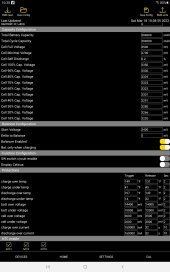Hey - I think I figured out a way to automate this top balancing process using only the built in balancing.
First, make sure you are set to only balance when not charging.
Then, under Parameter View, top two values:
- set the overvoltage to 3.55v
- set the overvoltage release to 3.45v
The BMS will charge up until whatever cell hits 3.55v, then charging will be turned off and active balancing kicks in.
The balancing will continue until the voltage in the highest cell drops to 3.45v, then the process starts again.
You will need to choose your two values (above) to fit your particular needs. the 3.55 / 3.45v seems to be working for me.
Then increase the values up to as high as 3.65 / 3.50v. Personally, I'll stop at 3.55 / 3.45 or maybe 3.60 / 3.45, but no higher, as it's not really necessary.
I'm just testing this now so I'll update if things don't go well.
I top balanced this 4s 160ah pack about 6 months ago and so far it's still plenty close enough, so this is just fine tuning it.
The way JBD "works" makes it pretty easy if sometimes lengthy to get things balanced (how long depends on how far out of balance the cells are).
When you turn off the "only balance on charge" setting, what it will do is burn down any cell above the voltage you set.
My method:
1. set to 3.45v and turn off balance only while charging, then charge until high cell voltage disconnect.
2. repeat this until all cells get above 3.45v
3. set balance voltage to 3.6v
4. again, charge until high cell voltage disconnect and let it discharge until all your cells are 3.6v
5. once they all are at 3.6v, I turn back on balance on charge only, and set balance to 3.4v
6. charge to 3.45v per cell, that is full (or greater than 95%, more like 98%)
Doing it this way and setting it back to default values will keep even grade B cells balanced for a very long time, more than 6 months.
Charging to 3.65v per cell on a regular basis is NOT a good idea, you put undue stress on the cells for miniscule return in capacity. The most out of balance set of cells (not actually very out of balance, only a few amp hours) takes about a day and a half, even less for the matched grade A cells. I just wanted to throw this out there, since people seem confused about how balancing works with JBD. Once you turn off the charge on balance, it will bring any cell above the balance set voltage down to that. Doing it this way means I get a very reliable BMS, no need to add additional ring terminals for an active balancer, and it just works with the defaults after it is done (balance only while charging, and balance voltage of 3.4v).




